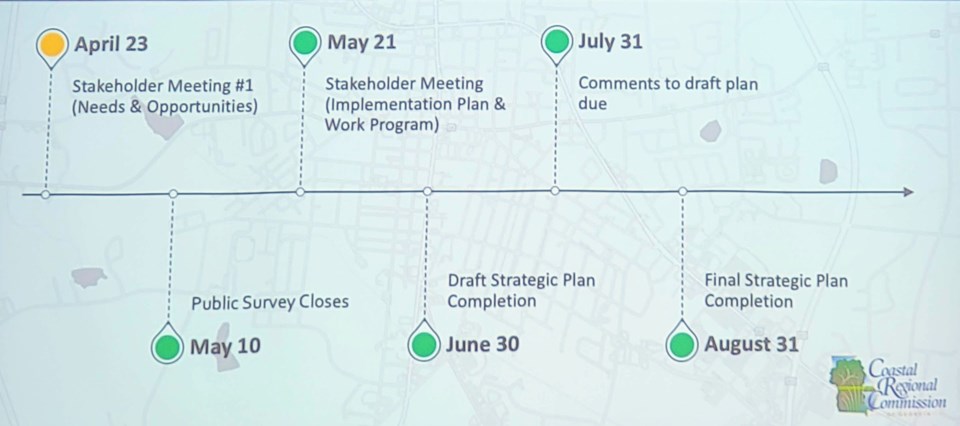The City of Statesboro has begun the process of updating its strategic plan, hosting the first of two planned stakeholder meetings on Thursday, April 23, 2025. The gathering, held at Statesboro First United Methodist Church, brought together residents and community members to provide input that will help shape the city's direction for the next five years (2025-2030).
The current strategic plan was last updated in 2018, and city officials are seeking fresh perspectives to ensure the new plan aligns municipal services and investments with the evolving needs and values of Statesboro residents and businesses.
Leading the session were consultants from the Coastal Regional Commission (CRC), including GIS Manager Wincy Poon, Planning and Assistant Executive Director Anna Carpenter, and Regional Planner Megan Norris. Poon explained the purpose of the meeting was to facilitate discussion and gather feedback in a neutral environment.
Participants engaged in a SWOT analysis exercise, identifying the city's internal Strengths and Weaknesses, and external Opportunities and Threats. Discussions focused on key areas such as city services, public safety, building and planning processes, recreation facilities, transportation, and utilities.
Key takeaways from the group discussions included a recognition of Statesboro's core strengths:
- The People and Community: Frequently cited as the city's "bread and butter," described as kind, welcoming, and supportive.
- Georgia Southern University: Seen as integral to the city's success, contributing arts, culture, activities, and growth.
- Geological Location: Central proximity to other major cities and airports.
- Relative Affordability: Overall relative low cost of living is an attractive quality for residents.
- Functional City Government: Praised for their bold, progressive leadership and being unified.
- Improving Public Transportation: The aiddion of and increases in transit buses was viewed positively.
However, stakeholders also identified significant challenges and weaknesses:
- Managing Growth: Concerns were raised about the strain on infrastructure, particularly roads and traffic congestion, as development increases.
- Housing Issues: Lack of affordable housing, workforce housing, and overall housing availability and quality were highlighted.
- Aging Infrastructure: The aging water treatment plant was specifically mentioned as needing urgent attention.
- Code Enforcement & Abandoned Properties: Enhanced enforcement needed, particularly regarding dilapidated and abandoned buildings, was a recurring concern.
- Lack of Certain Amenities: Affordable family entertainment options, crisis support facilities (like a homeless shelter), and senior recreation opportunities were noted as lacking.
Looking ahead, participants pointed to several opportunities for Statesboro:
- Economic Development: Attracting new businesses through incentives and supporting existing small businesses.
- Infrastructure Investment: Potential for expansion and updates, including city parks with a focus on accessibility.
- Regional Perception & Branding: Leveraging the positive view of Statesboro in the region ("Statesboro doing it right") and branding the city as an easy place to do business due to its permitting process.
- Strategic Annexation: The availability of adjacent developable land offers potential for managed growth.
- Creative Reuse of Space: Utilizing vacant buildings for public needs was suggested.
- Public Arts: Investing in murals and public art to enhance the city's appeal was seen as an opportunity.
Potential threats identified included:
- Unchecked Growth: The risk of growth outpacing infrastructure and school capacity.
- Quality of New Construction: Concerns about poorly built developments.
- Anti-Growth Sentiment: The challenge of balancing growth with community desires.
- Strained City/County Relationships: Potential difficulties in coordination and cooperation.
- Lack of State Investment: Reliance on local funds for large infrastructure projects like the water treatment plant.
- Labor Pool Strain: Competition for workforce from large incoming companies.
- Traffic Congestion: Exacerbated by state routes passing through the city.
- Flooding Risk: Increased with new development.
Following the group discussions, participants were asked to prioritize the top items identified using stickers, indicating which strengths to build upon, weaknesses to address, opportunities to pursue, and threats to mitigate.
In addition to the stakeholder meetings, the city is conducting a public survey to gather broader input. Residents are encouraged to participate in the survey, which remains open until May 10, 2025. Information and access to the survey can be found on the city's official website or by clicking here.
The next stakeholder meeting is scheduled for May 21, 2025. At this meeting, the prioritized list of issues will be reviewed, and discussions will focus on developing specific initiatives and work programs to address them.

The CRC team plans to work through drafting the strategic plan from June through August, with opportunities for community review before finalization.




